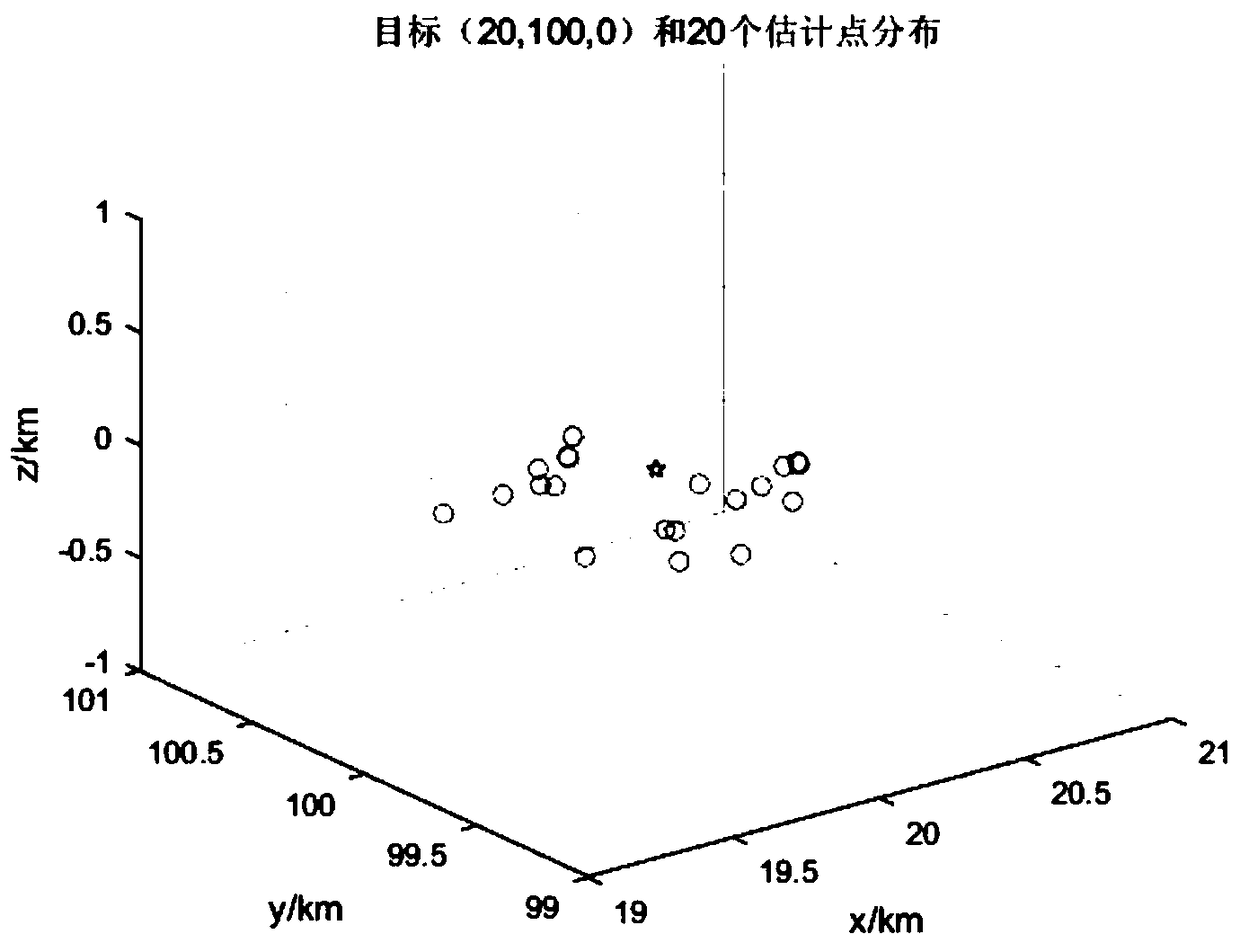Double-airplane passive positioning method based on azimuth angle and pitch angle information
A passive positioning and pitch angle technology, applied in positioning, radio wave measurement systems, instruments, etc., can solve the problems of large number of observation stations, large measurement errors, and low positioning accuracy, so as to achieve easy implementation, reduce the introduction of errors, The effect of strong mobility and flexibility
- Summary
- Abstract
- Description
- Claims
- Application Information
AI Technical Summary
Problems solved by technology
Method used
Image
Examples
specific Embodiment approach 1
[0027] The dual-aircraft passive positioning method based on azimuth angle and elevation angle information in this embodiment, such as figure 1 As shown, the method is realized through the following steps:
[0028] Step 1. Simulate the combat environment, and establish a space observation model between two observation aircraft and the target radiation source in the space Cartesian coordinate system; figure 2 shown;
[0029] Step 2. In the space observation model established in step 1, the relationship between the observation aircraft and the position coordinates of the target radiation source is obtained by using the observation information of the azimuth and elevation angles of the observation aircraft to observe the target radiation source arriving at the observation aircraft;
[0030] Step 3, using the space observation model established in step 1, transforming and simplifying the observation information obtained in step 2 to establish a matrix form of linear observation ...
specific Embodiment approach 2
[0034] The difference from Embodiment 1 is that in the dual-aircraft passive positioning method based on azimuth angle and pitch angle information in this embodiment, in the process of observing the relationship between the aircraft and the position coordinates of the target radiation source described in step 2, first determine The relationship between the observation plane No. 1 and the position coordinates of the target radiation source is expressed as:
[0035]
[0036] In the formula, the position coordinates of the target radiation source are u=(x T ,y T ,z T ) T , the position coordinate of the observing aircraft is S 1 =(x 1 ,y 1 ,z 1 ) T , θ 1 Indicates the azimuth angle at which the target radiation source arrives at the No. 1 observation plane, φ 1 Indicates the pitch angle at which the target radiation source reaches the No. 1 observation plane, r 1 Indicates the distance between the No. 1 observation plane and the target; θ 1 and φ 1 is the measured ...
specific Embodiment approach 3
[0041]The difference from the specific embodiment 1 or 2 is that the dual-aircraft passive positioning method based on azimuth and elevation angle information in this embodiment uses the space observation model established in step 1 described in step 3, and uses the space observation model obtained in step 2 In the process of transforming and simplifying the observation information to establish the matrix form of the linear observation equation, firstly, the process of establishing the matrix form of the linear observation equation of No. 1 observation plane is as follows:
[0042] Multiply both sides of the equal sign of the formula (2) obtained in step 2 for scalar r 1 ,but:
[0043]
[0044] Multiply the both sides of the equal sign of the formula (4) by A at the same time 1 ,Available:
[0045]
[0046] Let X=S 1 -u=(x 1 -x T ,y 1 -y T ,z 1 -z T ) T =(x,y,z) T , then formula (5) can be transformed into:
[0047]
[0048] Let A 1 The simplified form ...
PUM
 Login to View More
Login to View More Abstract
Description
Claims
Application Information
 Login to View More
Login to View More - R&D
- Intellectual Property
- Life Sciences
- Materials
- Tech Scout
- Unparalleled Data Quality
- Higher Quality Content
- 60% Fewer Hallucinations
Browse by: Latest US Patents, China's latest patents, Technical Efficacy Thesaurus, Application Domain, Technology Topic, Popular Technical Reports.
© 2025 PatSnap. All rights reserved.Legal|Privacy policy|Modern Slavery Act Transparency Statement|Sitemap|About US| Contact US: help@patsnap.com



